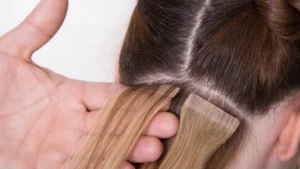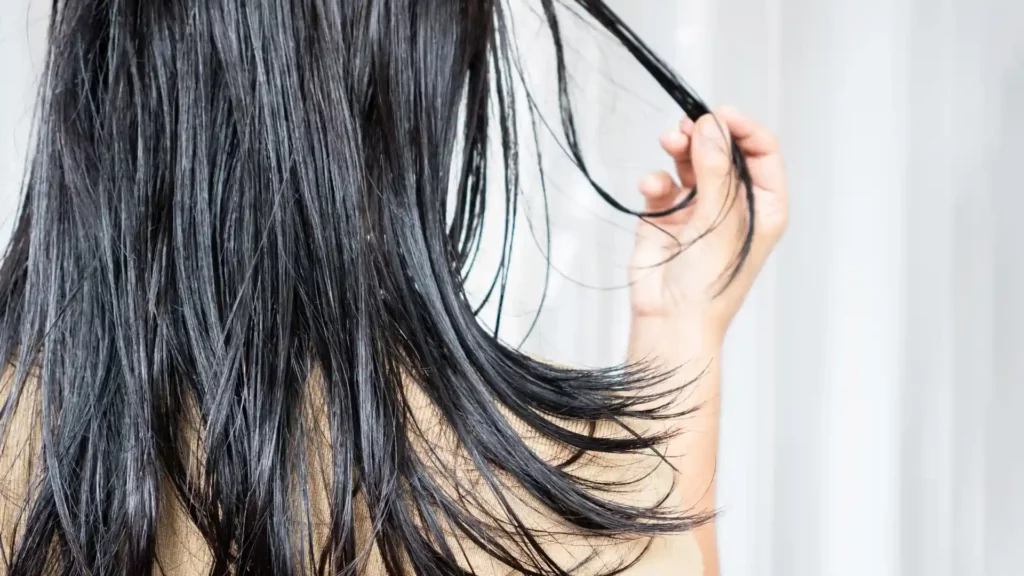Keep your new extensions looking as gorgeous on day 90 as they did on day one with our top, professional tips for maintaining your extensions. Your long locks look gorgeous, and you sat a long time to get them put in. Let’s keep them looking pretty, healthy, and natural. But remember, if you have an issue with the extensions, like coming loose or tangling, come back to Therapy Hair Studio for a quick fix. Contact our team today for more information.
How to Take Care of Your Professional Hair Extensions
Follow these five tips for maintaining hair extensions:
- Wash your extensions the right way – and don’t sleep with wet extensions.
- Book a weekly deep-conditioning session.
- Comb your extensions carefully.
- Avoid excessive heat styling.
- Separate the bonds each evening, and avoid tangling the extensions while you sleep.
Washing Your Extensions Correctly
Avoid hair products that strip the natural oils from your hair, like those containing sulfites and alcohol. Ask your stylist about the best shampoo and conditioner for your type of extensions and bonds. What you’d use for pre-tapered wefts differs from what you’d use for extensions bonded with micro rings. No matter what kind of product you use, washing with warm water is better than using scalding hot.
How you use your shampoo and conditioner is almost as important as what you use. It’s best to wash your hair in the shower and let the down-flowing water rinse it instead of in the tub or a sink with your head flipped upside down.
Sleeping with wet or damp hair can make your roots more tangled or cause the bonds to weaken and your extensions to fall out. Invest in a good-quality hair dryer and make sure your hair is thoroughly dry before bed.
Deep Conditioning Weekly Keeps Your Extensions Smooth
Your extensions don’t benefit from the natural oil your scalp produces to protect and nourish your natural hair, so it’s important to have weekly deep-conditioning treatments to keep your extensions soft, shiny, and healthy.
Products with coconut, macadamia, and argon oils are great natural conditioners. When applying the conditioner, avoid getting it on the roots – apply only to the extensions. Or you can try a hair masque, but check with your stylist about the products in the masque to make sure they won’t weaken the extension bonds.
Carefully Brush and Comb Your Extensions
Use your fingers or a wide-toothed comb to gently comb through your hair when it’s damp. Your hair is weaker when wet, so aggressive combing or yanking on tangles can weaken the extension bonds and cause breakage.
You may be used to brushing your natural hair from the root down, but this habit needs to be unlearned with extensions. Carefully start detangling at the ends of your hair, and slowly work your way up in sections. This reduces the strain on both your natural hair and the extensions.
Don’t Fry Your Hair
You can heat-style many extensions just as you would your natural hair, but limit how often you use heat styling. Even though our Hotheads Hair Extensions are made with Remy Human Hair and can be styled like natural hair, they can still be heat-damaged. Using a low-quality hair dryer, drying your hair on high heat, and heat styling daily can all cause brittle strands and split ends, just like what would happen to natural hair. Turn down the heat, or look for heatless options, like heatless curls.
Yes, you can still use your good-quality blow dryer, flatiron, curlers, or wavers, but just be careful how often you use them. Use a heat protectant before you heat-style – every time. You can ask your stylist or call Therapy Hair Studio for a recommendation.
How to Keep Your Extensions from Tangling in Your Sleep

Speaking of detangling, you’ll also need to check your bonds daily and ensure they haven’t gotten tangled. It sounds like a lot of work, but if you do it each day, it shouldn’t take more than a few minutes. Using your fingers, feel each bond and manually detangle it if it’s twisted.
Book Your Hair Extension Appointment Today
Do you want new extensions or need to have your current ones touched up? Book with our expert stylists now at Therapy Hair Studio. Our team will help you get your dream look and teach you more about the right hair extension care for your new hair. Contact us today at (713) 355-4247 for the long, luscious locks of your dreams.
Related Posts:









